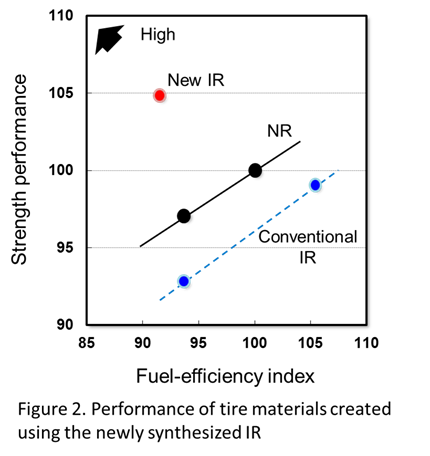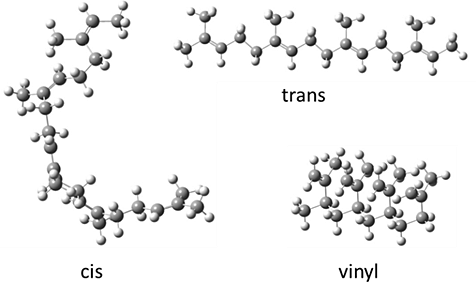About Bridgestone Corporation:
Bridgestone Corporation (BSJ), headquartered in Tokyo, is the world's largest tire and rubber company. In addition to tires for use in a wide variety of applications, it also manufactures a broad range of diversified products, which include industrial rubber and chemical products and sporting goods. Its products are sold in over 150 nations and territories around the world.
News - 2017
2017/02/24
Tokyo (December 13, 2016)-Bridgestone Corporation announced that it has succeeded in creating synthetic isoprene rubber (IR) through precise molecular structure control utilizing a new polymerization catalyst*1 developed proprietarily by the Company. The newly synthesized IR has the potential to contribute to the development of next-generation rubber with performance surpassing that of natural rubber. Moreover, the IR can be created using isoprene derived from renewable biomass and is therefore anticipated to be a sustainable material.*2 Going forward, we will evaluate the necessary conditions for the process of bringing this IR to practical application and determine how to secure a stable supply of isoprene with the aim of realizing practical application in the 2020s.

Natural rubber is an organic resource produced by the Para rubber tree. This resource is an important raw material to tire production due to its superior durability and wear resistance in comparison to synthetic rubber as well as its strong adhesiveness with reinforcement materials. As tire demand increases on a global scale, the amount of natural rubber consumed is projected to grow. Bridgestone has been advancing various research and development projects related to the Para rubber tree with the aim of securing a stable supply of natural rubber. At the same time, we are researching means of creating synthetic rubber with performance surpassing that of natural rubber.
Characteristics
By utilizing a new, proprietarily developed polymerization catalyst, we succeeded in synthesizing IR with exceptionally high molecular microstructure regularity*3 similar to the levels seen in natural rubber (cis selectivity: 99.0-99.9%). The IR also displays narrower polydispersity*4 than natural rubber or conventional IR (see Table 1).
Table 1. Characteristics of newly synthesized IR
| Conventional IR (Synthetic rubber) |
New IR (Synthetic rubber) |
Natural rubber | ||
|---|---|---|---|---|
| Molecular structure | Configurational unit | Isoprene | ||
| Cis selectivity | 94.0-98.5% | 99.0-99.9% | Nearly 100% | |
| Polydispersity | Broad | Narrow | Broad | |
Performance evaluations of the tire compound using the newly synthesized IR have indicated that it surpasses tire compounds using natural rubber in terms of strength performance and fuel-efficiency (see Figure 2).

The Bridgestone Group has defined the goal of working toward making 100% of the raw materials used in its tires sustainable materials by 2050. To accomplish this goal, we are advancing research and development activities on various raw materials, including natural rubber and polyisoprene.
New Gadolinium Catalyst
IR is usually manufactured using lithium (Li), titanium (Ti), or neodymium (Nd) catalysts. The gadolinium (Gd) catalyst Bridgestone developed is thus a completely new innovation. While it has been known that Gd catalysts have the potential to enable precise control of the molecular structure of IR, it was previously necessary for these catalysts to be used at temperatures below 0°C, which resulted in low activity and made manufacturing processes unfeasible. Bridgestone's newly developed Gd catalyst, however, features a structure designed to enable it to be utilized to control IR molecular structure at temperatures above 40°C, the range commonly used in manufacturing processes. Moreover, the new Gd catalyst demonstrates activity of 1,800 cycle min-1, roughly 600 times higher than the activity of conventional Gd catalysts, making its use all the more practical.
Bridgestone's Initiatives for Diversifying and Increasing the Productivity of Natural Rubber Resources
| Resource | Goal | Initiative |
|---|---|---|
| Para rubber tree | Increase in productivity and yield | Introduction of new agricultural materials and development of more sophisticated management techniques |
| Selection and multiplication of beneficial trees based on genome information (Genome deciphering, genetic markers) |
||
| Disease prevention | Techniques for early-stage diagnosis and eradication of diseases | |
| Other | Resource diversification and risk dispersion | Guayule, Russian dandelions |
*1. Polymerization catalyst
Polymerization refers to a phenomenon or reaction in which two or more molecular compounds with simple structures fuse to form a different compound with a higher molecular weight. Polyisoprene is created through a polymerization reaction of isoprene.
A catalyst is a substance that increases the rate of a chemical reaction, for example, the creation of polyisoprene.
*2. Sustainable material
The Bridgestone Group defines "sustainable materials" as materials that are derived from resources with a continual supply, can be used as part of our businesses over the long term, and have a low environmental and social impact throughout their whole lifecycle, from procurement to disposal.
*3. Molecular microstructure regularity
Polyisoprene configurational units can be linked via cis, trans, or vinyl isomers, and compounds usually contain a mixture of these three isomers. A high ratio of cis isomers is generally thought to contribute to higher performance.

*4. Polydispersity
The length of one molecule of polyisoprene generally varies, resulting in polydispersity.
